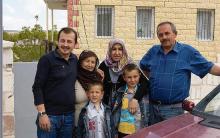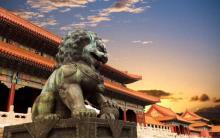They are considered a new type of museum. From the very first day of its work, it was stated that it would be an interactive platform for amateurs and experts national history. And, first of all, for young people.
Museum building
The Streletsky Chambers Museum is also known as the Titov Chambers. Initially, they got their name from the name of their first owner - the Duma clerk, whose name was Semyon Stepanovich Titov. He was a particularly close person to Tsar Alexei Mikhailovich Romanov.
The building itself, which houses the museum today, was built in XVII-XVIII centuries. It is located in the very center Russian capital. And, by the way, it is of great architectural value. The façade and interiors of the chambers have been preserved to this day.
IN early XVII For centuries, Titov’s descendants still owned the property. The children treated the territory with care. They expanded it significantly by purchasing a neighboring plot of land with a garden. The house itself has become larger.
Modern history of the building

WITH late XVIII centuries and before October revolution The building was owned by a number of owners. Only fragmentary information has been preserved about most of them. As a result, the house became profitable, and because of this, its layout and structure changed significantly.
It is known that under the owner named Serikov, apartments began to be rented out. The last pre-revolutionary owner of the building was the wealthy peasant Korolev. During his time, water supply was installed in the house and a sewer system was installed.
In the 30-40s of the 20th century, the wooden buildings on the site of the future Streletsky Chambers museum were demolished. Instead, a nine-story building was built, which occupied most of the territory. As a result, the chambers themselves ended up in the courtyard, between two buildings.
Organization of the museum

The Streltsy Chambers Museum first opened its doors to visitors in 2014. Various cultural events began to be held there on a large scale. For example, this is “Night at the Museum” or “Library Night”. The Art Night art marathon is also regularly held. creative evenings or meetings with front-line soldiers, participants in real combat operations.
Throughout its operation, the museum military history"Streltsy Chambers" actively cooperates with various government agencies. Organizes many creative projects, in which the Moscow Kremlin Museum-Reserve takes part, Tretyakov Gallery, Museum of the Great Patriotic War, Central Museum of the Armed Forces of the Russian Federation.
The basis of the exhibition

Of course, the basis of the exhibition of the Streltsy Chambers museum in Moscow is the Streltsy. Here, with the help of the most modern technologies, they tell about the history of the first regular army in Russian history, which today, unfortunately, is undeservedly forgotten.
The staff has a variety of multimedia exhibits at their disposal, allowing visitors to immerse themselves deeply into historical era, for example, get acquainted with the traditional activities of the Streltsy and their way of life, find out how different layers of society lived during the times of Ivan the Terrible, as well as Tsar Alexei Mikhailovich and Peter I, the emperor under whom the history of the Streltsy ended.
The RVIO Museum "Streltsy Chambers" displays the uniform of the archers, their traditional dress, household items and weapons. Visitors have a unique opportunity to feel like archers. To do this, they can try to load a musket, master the drumbeat to which soldiers went into battle, and learn to write in accordance with ancient Russian canons.
Another unique function that museum visitors can take advantage of is the so-called. A unique key to it is the unique barcode that is present on each ticket. With its help, it becomes possible to get to special areas and interact with interactive areas of the museum. These can be exciting multimedia projections, convenient touch screens, as well as others modern technologies, which allow us to examine in detail all the features of the life and everyday life of Russian archers, and immerse ourselves in their era.
"Heroes of the Fatherland"
The Strelets Chambers Museum also organizes independent temporary exhibitions. For example, the exhibition St. George's History of Russia was very popular." It tells about the history of the creation of the order itself, as well as its gentlemen, the order and features of the award.
Among the temporary exhibitions in the Streltsy Chambers Museum, the exhibition “Soldiers of the Fatherland” is also popular. It was opened on the 120th anniversary of the birth of Marshal Rokossovsky. Its key exhibit is the saber that Rokossovsky commanded at the Victory Parade on Red Square in 1945.
The exhibition also features the commander’s personal belongings, his letters, and unique photographs from family sources. In addition, you can find out the fate of his descendants, see with your own eyes the Polish and Soviet marshal uniforms, listen to the music that Rokossovsky loved, touch the records that he personally played on his home gramophone. There is also a pouch, which the military leader did not part with even in the most fierce battles. It is worth noting that many of these exhibits are on public display for the first time.
Cultural life of the museum

It is noteworthy that in addition to cultural events All-Russian events, such as the “Night of the Arts”, the museum constantly organizes its own original events.
These could be historical public lectures, round tables with the participation of historians and specialists working in the Russian Military Historical Society. Lessons on courage are held for schoolchildren, and meetings with interesting and unique people are organized.
The museum takes great care to ensure that the exhibition is interesting and relevant. For this purpose, exhibitions of contemporary photographers and painters are regularly organized.
How to get to the museum?

The Streletsky Chambers Museum is located in Moscow at Lavrushinsky Lane, building 17, building 1. The easiest way to get to the museum by public transport is to go to the Kitay-Gorod Moscow metro station.
This is the center of Moscow. Nearby are Maroseyka Street, Old Square and Pokrovsky Boulevard. Arriving at the museum, you can examine a large number of sights and just interesting places in District. This Peter and Paul Cathedral, Trinity Church, St. John the Baptist Monastery, Travel Museum.
What is the price?
In order to enter the museum, you must purchase a ticket. The cost of a separate visit to the Streletsky Chambers costs 350 rubles. You can purchase a comprehensive ticket and also visit the Museum of Military Uniforms, located nearby. In this case, you will have to pay 500 rubles.
To make it more interesting and exciting for visitors to get acquainted with the composition, you can use a large list additional services. For example, a photo shoot in historical costume will cost 100 rubles, and for 200 rubles you can take part in a quest.
You will have to pay an additional 100 rubles for a tour of " Streletsky Chambers"The program includes a visit to all the halls of the museum and its territory. Be sure to reserve time. The tour lasts about an hour and a half.
The establishment’s employees are ready to surprise you and amaze you with completely unexpected offers. For example, celebrate a child’s birthday in Streltsy costumes in the interior of that era.
A museum of the Russian military opened in Moscow historical society- Museum military uniform clothes
Started work on February 2 new museum Russian Military Historical Society - Museum of Military Uniforms. The first exhibition is “Rescued Relics”, which presents the Russian military uniform XVIII – XIX centuries, dedicated to the memory of those killed in a plane crash near Sochi on December 25, 2016, to the memory of Anton Nikolaevich Gubankov, Director of the Department of Culture of the Ministry armed forces Russian Federation.
The opening ceremony of the exhibition was attended by: Head of the Moscow Department of Culture Alexander Kibovsky, Advisor to the Chairman of the Russian Military Historical Society Rostislav Medinsky, Executive Director RVIO Vladislav Kononov, executive director of the Museum of Military History Marina Nazarova, director of GosNIIR Dmitry Antonov, representatives of the Ministry of Defense of the Russian Federation, Central Museum armed forces, Borodino Field museum-reserve, restoration organizations, museum community, collectors and military history buffs. The youngest guests of the exhibition were pupils cadet class Moscow gymnasium.
We have been preparing for this event for more than a year. Then we did not know what tragic event and what wonderful person this exhibition would be dedicated to. This exhibition is a tribute and tribute to Anton Gubankov. Today we present best exhibits, which were kept in the Imperial Quartermaster Museum. I invite everyone to honor the memory of those killed in the plane crash on December 25, 2016 with a minute of silence,” said Vladislav Kononov.
History of the creation of the exhibition " Rescued relics"began in 2016, when the director of the Department of Culture of the Ministry of Defense, Anton Nikolaevich Gubankov, supported the idea of transferring about 300 items from the storerooms of the Ministry of Defense Museum to the Russian Military Historical Society for their restoration and display. The restoration lasted almost a year and today an exhibition with samples of Russian military uniforms XVIII - XIX century received its first guests.
This is an event that has been awaited for many years by those who are proud of the military glory of our Fatherland. This is a unique collection that needed to be given museum status. Make sure that it gets to people and receives restoration care, thanks to the efforts of the Russian Military Historical Society. Anton Nikolaevich would definitely be here if fate had not decreed otherwise. The man is not with us, but the echo of his good deeds remains with us. Everlasting memory, - said Alexander Kibovsky at the opening ceremony.
The restoration and sometimes revival of the priceless collection was carried out by specialists from three leading organizations: GosNIIR, VKHNRTS im. I.E. Grabar and ROSIZO with the support and active participation of the Russian Military Historical Society. A year after the start of restoration work, after a hundred years of oblivion to a wide circle visitors are shown priceless rarities of military uniforms.
The exhibition presents unique exhibits of Russian military uniforms of the 18th-19th centuries from the Museum of the History of Military Uniforms, created on the basis of the collection of the Imperial Quartermaster Museum, which existed before the revolution under the auspices of Russian Emperor. Among them: military relics and uniforms of the Life Guards Cavalry Regiment, the Life Cuirassier of His Imperial Highness the Heir to the Tsarevich Regiment, the Life Guards of the Pavlovsk Regiment, the Life Guards of the Preobrazhensky Regiment, the 68th Life Infantry Borodino His Majesty Regiment, the Nizhny Novgorod Dragoon Regiment, Companies of Palace Grenadiers and other weapons from private collections.
For reference:
The “sample store”, established by Peter I, received items of military uniform not only Russian army, but also foreign regiments, as well as design samples of uniforms. In 1868, on the basis of the collected objects, the Quartermaster Museum was born and by the highest Decree of Alexander II it was ordered to collect as standard samples military uniforms, as well as experienced, experimental ones, in order to “preserve examples of military uniforms for history.”
After the events of 1917, the life of the museum ceased: the exhibits were put into boxes and sent for storage to the Peter and Paul Fortress. In 1932, the unit was transferred to the artillery historical museum, some went to the costume departments of theaters. Most of the exhibits remained in storage rooms, deteriorated, and wandered around the vast country. Only since 1959 the collection became available to a limited circle of specialists at the development base of the Central Clothing Directorate, organized by the Clothing Supply Directorate of the USSR Ministry of Defense.
located in the Shchelkovsky district of the Moscow region near the Bakhchivandzhi platform.
The Museum of Military Uniforms was created on the basis of the collection of the Imperial Quartermaster Museum, which existed before the revolution under the patronage of the Russian Emperor. The Highest Decree ordered the collection of both standard samples of military uniforms, as well as experimental, experimental ones, in order to “preserve samples of military uniforms for history.”
2. During the revolution, the commissary museum was partially looted and partially destroyed. The remains of the collection of the quartermaster's museum were transferred: partly to the museum of artillery, engineering troops and signal troops; partly to theaters and film studios; partly to the quartermaster department of the Red Army, for use as samples of military uniforms.
3. Regular units, and with them a uniform uniform, appeared under Peter I. The soldiers wore a caftan: green in the infantry, and blue in the cavalry, a single red cloth camisole for all, tricorn hats and a sword belt with a sword. Officers also received a scarf and a distinctive badge on their chest. Peter I gave great importance appearance of his warriors, he made sure that they looked decent and at the same time had equipment convenient for battle. 
4. The exhibits presented in the museum tell how the military uniform appeared and changed in Russia, which was proudly worn by many generations of defenders of the Fatherland. 
5. For a long time, the collection existed at the research laboratory of military uniforms of the quartermaster service of the Ministry of Defense and was shown only to specialists. Now the museum is open to anyone interested in military uniforms. 
6. The vast majority of exhibits are historical originals. 
7. 
8. Loops for orders and medals are visible on this uniform. 
9. The uniform of our army changed quite often, largely due to the fascination of statesmen with European outfits 
10. For the first time Soviet times the exposition did not fare well. Some exhibits were donated to other museums, others were given to theaters and film studios. A lot of things were simply sold out. And what was left was put in boxes and locked in a warehouse. The museum was revived only after the war, when the surviving rarities were returned to the Main Quartermaster Directorate. But only in 1985 the exhibits were housed in a modern heated building, equipped entirely by the rear services. 
11. In these halls you will learn a lot of interesting things about everyday things and names familiar from childhood. For example, foragers for a long time were the only servicemen of the Russian army who had a visor attached to their headdress. But not out of force and not as a sign of distinction, but for purely practical purposes: it was believed that such a hat was very convenient for measuring oats for horses. 
12. For a soldier, a uniform has always been something more than just clothes. It is not for nothing that upon dismissal from military service the right of former military personnel to wear military uniforms was specifically stipulated. This was given importance as one of the types of encouragement and recognition of merit. 
13.
14.
15.
16.
17.
18..
19.
20. The history of the appearance of shoulder straps and epaulettes is interesting. Initially, epaulettes - dense metal plates - served as protection against saber strikes, and shoulder straps were convenient in that they protected the upper part of the uniform from rapid wear when the weapon was positioned “on the shoulder.” In addition, they seemed to hold together the remaining parts of the uniform - a sword belt, a sling, and backpack straps. The insignia on them appeared later. 
21. Stuffed horse of Voroshilov named Mauser. 
22. 
23. The museum has a large exhibition of military uniforms and the post-revolutionary period.
Each cavalry regiment had its own cap color, and there were as many as 128 such regiments. 
24.
25. Standards for the Victory Parade. First option. 
26.
27. When on June 27, 1945, the Presidium of the USSR Armed Forces awarded Stalin the title of generalissimo, the question arose: what uniform would henceforth suit the commander-in-chief? Development of a uniform for the owner of a unique military rank entrusted to the Chief of Logistics of the Armed Forces, General Khrulev. The chief quartermaster presented the sewn uniform Soviet army Drachev. Seeing the “outfit,” Stalin winced. He didn’t like the numerous braids, luxurious gold epaulettes and gold stripes on his trousers. Having put Drachev out, the leader told his subordinates that he did not want to look like a rooster or a doorman from a restaurant. There was no need to explain it twice: a few days later they presented a more modest uniform - a woolen jacket with a turn-down collar. He got it highest approval. Now both versions of the Generalissimo uniform can be seen in a single place - the Museum of Russian, Soviet and Foreign Uniforms of the Central Clothing Directorate of the Ministry of Defense of the Russian Federation. 
28.
29.
30.
31.
32.
33.
34.
35. The museum has a large collection of awards from different countries. 
36.
37.
38.
39.
40.
Thanks to the Moscow Region press center military_press
for an interesting excursion.
The museum is located on the territory of a military unit and is a “sensitive” facility, and therefore it is necessary to apply for a visit in advance.
Due to the “fading” of exhibits from camera flashes, the museum has a certain lighting regime and photography is subject to special orders.
Telephone: 74956481813
Address: Moscow, Russian Federation, Moscow, Petroverigsky lane, 4.
In February 2017, a new museum of the Russian Military Historical Society, the Museum of Military Uniforms, opened in the building of the Turgenev-Botkin estate. The first exhibition “Rescued Relics” introduces visitors to individual examples of Russian military uniforms of the 18th–19th centuries. The exhibition has become a memorial - it is a memory of those who died in the Sochi area on December 25, 2016, of Anton Nikolaevich Gubankov, Director of the Department of Culture of the Ministry of Defense of the Russian Federation. He supported the idea of transferring items from the storerooms of the Ministry of Defense Museum to the Russian Military Historical Society for their restoration and display within the walls of the Museum of Military Uniforms of the Russian Military Historical Society. Among them are real relics - priceless items of military uniform from the Imperial Quartermaster Museum. It received items of military uniform not only from the Russian army, but also from foreign ones. The life of the museum ceased after the events of 1917: the exhibits were put in boxes and sent for storage to the Peter and Paul Fortress. In 1932, the wanderings of the priceless collection began: some were transferred to the artillery historical museum, some went to the costume departments of theaters. Restoration of the priceless collection began in 2016, with the direct participation of the Russian Military Historical Society. A year after the start of restoration work, after a hundred years of oblivion, visitors can see amazing exhibits. All items tell about the feat of the warriors who wore this uniform and were proud of it.
I hesitated for a long time whether to go or not this museum, where the Ministry of Defense organized a press tour, but on the last day I finally got up and went. I didn’t regret it at all and was wildly pleased, because the place was really interesting.
Briefly the history of the museum is as follows. On the basis of the quartermaster department under Alexander II, the Imperial Quartermaster Museum was created where all samples of military uniforms, sketches, and “beta versions” of various uniforms that were not included in the series were brought. In 1917, the exhibits were placed in boxes, and for 15 years they quietly fell into disrepair in Peter and Paul Fortress. In 1932, a commission was created that examined the collection and distributed it as follows: most of exhibits are transferred to the Museum of Artillery, Engineering Troops and Signal Corps, some to film studios and theaters, and some to the Quartermaster Department of the Red Army as samples. In 1949-1950, many exhibits were transferred from the Artillery Museum to the quartermaster's department, where they were again eight for long years went into boxes. Finally, in 1958, they were recovered White light and were placed in a military unit in Odintsovo, where there were no special conditions for storage. Since 1985, the museum has been located in its current building in Bakhchivandzhi.
Filming. You understand that I’m not a pro, and I had to shoot in a poorly lit room, and even through glass, which constantly tried to glare and reflect myself.
The next problem is photo captions. There wasn’t much time, and on the contrary, there were a lot of exhibits, so there was no way to remember everything. I can comment on some things, Tarlit will post some things, and he is a recognized specialist in form.
Well, let's go.
Tapestry from the late 18th century. It took the master about 28 years to weave it.
Various shape.



These pants are called chikchirs.



There are no darned places on the uniform, but thread loops on which awards were previously worn.

Hats.








And this is a helmet for the crews of armored vehicles of the First World War.

Gymnastic shirts for sports. Subsequently, they were transformed into the famous tunics.

Shoulder strap with the monogram of Alexander III.

Epaulet.


The Generalissimo's uniform, made for the 1945 Victory Parade. On the left is the first option, which was rejected by Stalin, apparently because it looked like a doorman, and on the right is the one in which the leader of the peoples was on Red Square.

Experimental uniform of a colonel of the Soviet army. The sides and back of the hat fold back (turn-down backplate) and there is a fabric flap to cover the face (windproof flap).

There are also foreign samples of the uniforms of various states.
German Democratic Republic.

USA

The exhibits include various household items.
Soap. There is not mold on it, but inclusions of tar.

This is not a flask for chemical experiments, and a glass flask for water.

Here is another option from the Soviet era.

Soldiers' hospital shoe covers from the 19th century.

Leather bag - tashka.

Rare trunk.

After February revolution In 1917, the Provisional Government decided to get rid of royal symbols. The question arose of what to do with the battle flags of the regiments. They got out of it simply - they sewed rags onto the double-headed eagle and the word “king”.

Soviet banners from the Great Patriotic War.



Models of military carts with special alphanumeric designations.
Steam-window carriage PH-I.

Horse-mounted machine-gun cart KPT.











Annexation of the Crimean Khanate to Russia Abolition of duties and the mint
Church of St. Dmitry the Myrrh-Streaming in the field
Group Bible Reading and Study Time of Voluntary Infirmity
Meat with eggplants and tomatoes in the oven Ragu with white wine
How to properly and tasty cook pancakes with cottage cheese